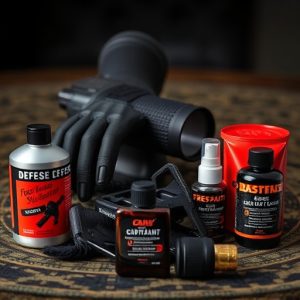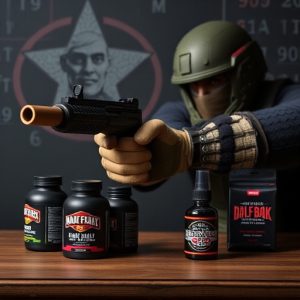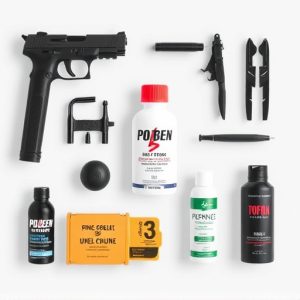Optimizing Your Safety: A Guide to Non-Lethal Personal Defense Products
Personal defense products offer non-lethal alternatives for self-protection, designed to incapacita…….
Personal defense products offer non-lethal alternatives for self-protection, designed to incapacitate or deter attackers while prioritizing user and bystander safety. These include pepper spray, which temporarily impairs an assailant's sensory functions, and stun guns, which deliver a harmless electric shock. Additionally, personal alarms and defensive sprays can attract attention and act as effective deterrents. When selecting a product, it's important to consider its legality, ease of use under stress, and how it fits with your personal circumstances and training. Knowledge of local laws on self-defense products is crucial to prevent legal issues. Selecting a device that matches your comfort level, physical abilities, and the types of situations you may encounter is key. A comprehensive understanding of these products' mechanisms, effective use, and legal considerations will help users make informed decisions for their personal safety. Training in the use of personal defense products is essential for proficiency and ensuring actions are justified under the law, maintaining both personal and community safety.
When it comes to ensuring one’s safety in potentially threatening situations, understanding the array of personal defense products available is paramount. This article delves into the efficacy of non-lethal self-defense tools suitable for everyday carry and provides a guide to selecting the right components for your personal defense arsenal. Key factors influencing these choices are examined alongside the critical aspects of training and legal considerations that underscore responsible personal defense use. With the right knowledge, tools, and adherence to legal frameworks, individuals can confidently safeguard themselves without resorting to lethal force.
Understanding Personal Defense Products: A Comprehensive Guide
When considering personal defense products, it’s crucial to evaluate the range of options available that can provide protection without resorting to lethal force. These products are designed with the intent to incapacitate or deter an assailant, thereby ensuring your safety while minimizing potential harm. Pepper spray, for instance, is a widely recognized non-lethal self-defense tool. It utilizes a powerful chemical compound that can temporarily impair an attacker’s vision and respiratory functions, providing you with a crucial escape window. Stun guns are another option, delivering an electric shock that can subdue an aggressor without causing permanent injury. Both of these devices come in various forms and sizes, catering to different user preferences and situational demands. Additionally, personal alarms and defensive sprays are effective in drawing attention to your predicament, deterring potential threats by signaling to bystanders or alerting law enforcement.
Selecting the right personal defense product involves considering factors such as legal restrictions, ease of use under stress, and the specific contexts in which you may find yourself vulnerable. It’s important to familiarize yourself with state and local laws regarding self-defense products to ensure compliance and avoid unwanted legal entanglements. Further, choosing a defense product that suits your personal comfort level and capabilities is paramount. Training on the use of these devices can enhance your confidence in their application and effectiveness, ensuring you are prepared should the need arise. Understanding personal defense products requires a combination of knowledge about their mechanisms, how they can be used effectively, and the legal framework governing their possession and use. This guide aims to provide readers with a clear and informative overview of the options available for non-lethal self-defense.
The Efficacy of Non-Lethal Self-Defense Tools: Options for Everyday Carry
Non-lethal self-defense tools have become increasingly popular as individuals seek to enhance their personal safety without resorting to firearms. The efficacy of these tools lies in their ability to neutralize a threat quickly and effectively while minimizing the potential for serious injury or fatality. Pepper spray, for instance, utilizes an irritant that can incapacitate an attacker by causing intense eye pain, difficulty in breathing, and temporary loss of vision, thereby giving the user time to escape. Stun guns or Tasers deliver a high-voltage electrical shock, which can also immobilize an aggressor without causing lasting harm. Both options are designed for ease of use and are among the most widely accepted personal defense products for everyday carry due to their legal status and effectiveness in deterrence.
When considering personal defense products for everyday carry, it’s important to evaluate factors such as legality, practicality, and personal comfort with the tool. Keychain alarms can be a loud deterrent, alerting bystanders and potentially scaring off an assailant without direct physical contact. Personal alarm systems are another non-lethal option that emits a high-decibel sound to attract attention and disorient an attacker. Additionally, personal defense products like defensive flashlights can illuminate dark environments while also delivering a temporary blinding light as a self-defense mechanism. Regardless of the choice, these tools should be part of a comprehensive personal safety plan that includes awareness, avoidance, and the willingness to seek help in situations where conflict is unavoidable. Understanding the capabilities and limitations of each product will empower users to make informed decisions about which non-lethal self-defense tool best suits their needs for personal protection.
Key Considerations When Selecting Your Personal Defense Arsenal
When assembling your personal defense arsenal, it’s crucial to consider a variety of factors that will influence the effectiveness and appropriateness of the products you choose. Firstly, assess the legal restrictions in your region regarding personal defense products to ensure compliance with local laws. Secondly, evaluate your own physical capabilities, comfort level, and situational needs. Pepper spray, stun guns, and personal alarm systems are popular non-lethal options that can be effectively integrated into your defense strategy based on their strengths and limitations. Pepper spray, for instance, offers a quick incapacitation with a range that allows you to maintain a safe distance from a threat. Stun guns provide an alternative means of immobilizing an attacker but typically require close contact. Personal alarm systems can deter would-be assailants by drawing attention and deterring them through the loud audible alert. Additionally, consider products that complement each other, such as combining a stun gun with a flashlight for double functionality in low-light conditions. It’s also advisable to select products that come with training materials or opportunities for hands-on practice to ensure you are well-versed in their use. Regularly review and practice with your personal defense products to maintain proficiency, as skill degradation can compromise effectiveness when it matters most. By carefully selecting the right mix of non-lethal personal defense products tailored to your specific needs and legal environment, you can significantly enhance your safety and preparedness for potential threats.
Training and Legal Implications: Mastery and Responsibility in Personal Defense Use
Non-lethal defense products offer a critical alternative for individuals seeking to protect themselves, their families, and their properties without resorting to lethal force. The efficacy of these personal defense products hinges on the user’s proficiency in deploying them correctly and safely. Comprehensive training is paramount to ensure that when faced with a threatening situation, the user can respond effectively while minimizing the risk of harm to themselves or others. Training programs typically cover a range of topics, from understanding the mechanical functions of devices like pepper sprays and stun guns to simulating real-life confrontations to reinforce proper response protocols. This hands-on experience is crucial for building muscle memory and decision-making skills under stress.
Moreover, the legal implications of using non-lethal defense products cannot be overstated. Laws governing their use vary by jurisdiction, and users must familiarize themselves with local regulations to avoid unintentional violations. Understanding the legal framework within which these products can be used is not just a matter of responsibility but also of personal protection. It ensures that in the event of an altercation, the user’s actions are lawful and justified, potentially avoiding legal complications or unnecessary force. Users must also consider the potential consequences of using a non-lethal defense product against a perpetrator, including the possibility of physical injury or property damage, which must be weighed against the immediate threat faced. A well-informed user, equipped with proper training and knowledge of the law, is better prepared to use non-lethal personal defense products effectively and within the bounds of legality.


